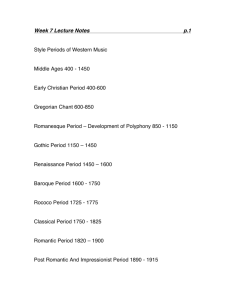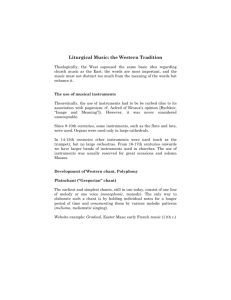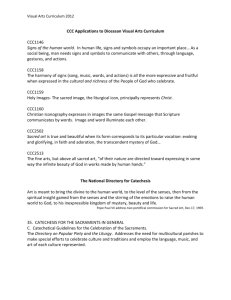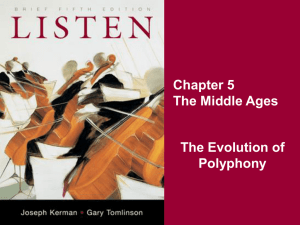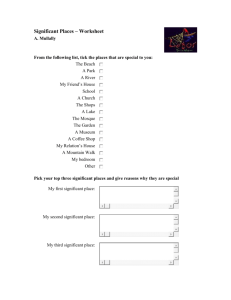Sacred Polyphony - Basilica of Saints Peter and Paul
advertisement
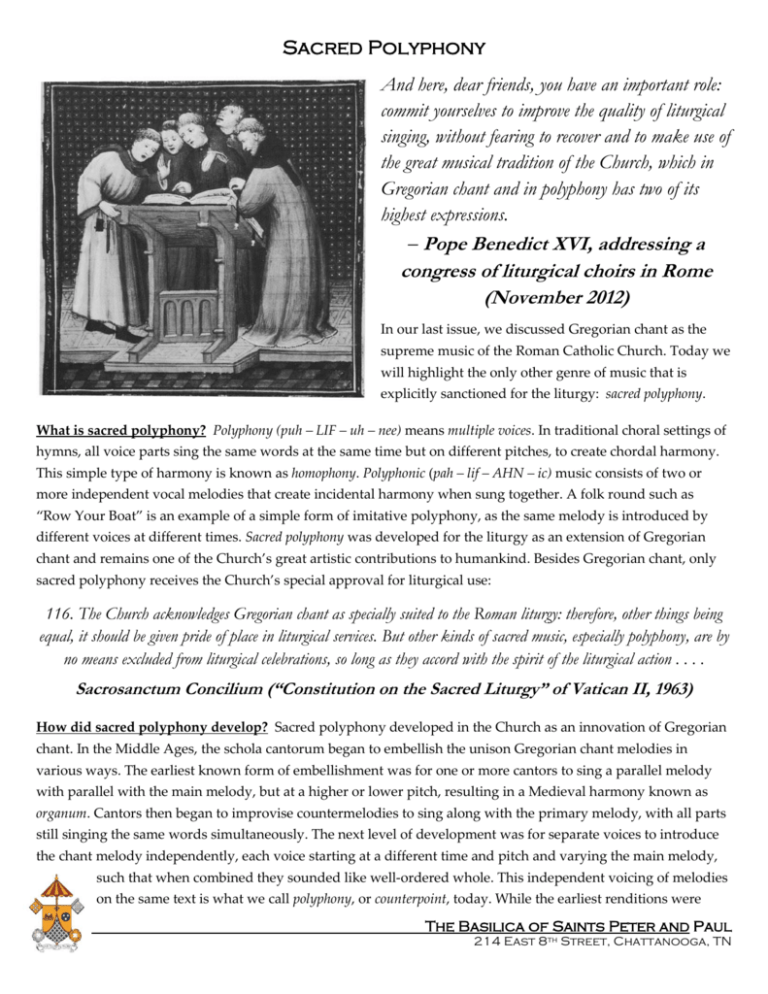
Sacred Polyphony And here, dear friends, you have an important role: commit yourselves to improve the quality of liturgical singing, without fearing to recover and to make use of the great musical tradition of the Church, which in Gregorian chant and in polyphony has two of its highest expressions. – Pope Benedict XVI, addressing a congress of liturgical choirs in Rome (November 2012) In our last issue, we discussed Gregorian chant as the supreme music of the Roman Catholic Church. Today we will highlight the only other genre of music that is explicitly sanctioned for the liturgy: sacred polyphony. What is sacred polyphony? Polyphony (puh – LIF – uh – nee) means multiple voices. In traditional choral settings of hymns, all voice parts sing the same words at the same time but on different pitches, to create chordal harmony. This simple type of harmony is known as homophony. Polyphonic (pah – lif – AHN – ic) music consists of two or more independent vocal melodies that create incidental harmony when sung together. A folk round such as “Row Your Boat” is an example of a simple form of imitative polyphony, as the same melody is introduced by different voices at different times. Sacred polyphony was developed for the liturgy as an extension of Gregorian chant and remains one of the Church’s great artistic contributions to humankind. Besides Gregorian chant, only sacred polyphony receives the Church’s special approval for liturgical use: 116. The Church acknowledges Gregorian chant as specially suited to the Roman liturgy: therefore, other things being equal, it should be given pride of place in liturgical services. But other kinds of sacred music, especially polyphony, are by no means excluded from liturgical celebrations, so long as they accord with the spirit of the liturgical action . . . . Sacrosanctum Concilium (“Constitution on the Sacred Liturgy” of Vatican II, 1963) How did sacred polyphony develop? Sacred polyphony developed in the Church as an innovation of Gregorian chant. In the Middle Ages, the schola cantorum began to embellish the unison Gregorian chant melodies in various ways. The earliest known form of embellishment was for one or more cantors to sing a parallel melody with parallel with the main melody, but at a higher or lower pitch, resulting in a Medieval harmony known as organum. Cantors then began to improvise countermelodies to sing along with the primary melody, with all parts still singing the same words simultaneously. The next level of development was for separate voices to introduce the chant melody independently, each voice starting at a different time and pitch and varying the main melody, such that when combined they sounded like well-ordered whole. This independent voicing of melodies on the same text is what we call polyphony, or counterpoint, today. While the earliest renditions were The Basilica of Saints Peter and Paul 214 East 8th Street, Chattanooga, TN improvised, composers in the Renaissance era began to write out their polyphonic compositions so that others could sing them. Because the musical notation for many of these compositions has been preserved and is now freely published within the sacred music community, we are fortunately able to hear and sing them still today. What is a motet? Motets are polyphonic choral compositions of the Scriptural propers of the Mass and other sacred texts. Motets are commonly scored for three or four voice parts. Complex polyphony for double choir and six or more voice parts, while quite challenging for choirs to prepare, is not unusual. Claudio Monteverdi’s Spem in alium is well known for having forty voice parts! Who are the chief composers of polyphony? The period from 1400 – 1650, including the Renaissance and early Baroque eras, is called the “golden age of polyphony.” Important composers of sacred polyphony during this period include Josquín Desprez, Cristóbal Morales, Giovanni Pierluigi Palestrina, Tomás Luis de Victoria, William Byrd, Thomas Tallis, and Orlando di Lasso. (Search for these composers on youtube to hear examples.) Polyphony continued to develop after this period, and new sacred polyphony is still being written today. How can polyphony help us worship? The rich fullness of sacred polyphony presents a stunning complement to the pure serenity of Gregorian chant. Some motets have a polyphonic antiphon that is sung in alternation with unison chanted verses, illustrating the beauty of that contrast. Composers have written full polyphonic settings of the sung Ordinary (i.e., the Kyrie, Gloria, Credo, Sanctus, and Agnus Dei). It takes a prepared choir to sing multivoiced compositions like these. Other members of the congregation participate by listening to the prayer sung in a magnificent way and offering that same prayer together. Pope Emeritus Benedict XVI explained it thus: I would like to underscore that active participation of the whole People of God in the liturgy does not consist only in speaking, but also in listening, in receiving the Word with the senses and with the spirit, and this goes also for liturgical music. You, who have the gift of singing, can make the hearts of so many people sing in liturgical celebrations. – Pope Benedict XVI, addressing a congress of liturgical choirs in Rome (November 2012) Do we hear polyphony at the basilica? Discovering the treasure of sacred polyphony is an important aspect of our Joy of Tradition initiative at the Basilica of Saints Peter of Paul. Polyphonic music requires skill and effort to learn and sing well. While we do not yet sing a polyphonic piece at every Sunday Mass, our choirs are gradually building a repertory of sacred polyphony to complement the chant we sing in both forms of the Roman rite. We have adopted pieces written by Victoria and Palestrina, as well as later composers. The schola has prepared several pieces of choral music to sing for Holy Week. Listen and see if you can distinguish which ones are polyphonic motets. Next, we will introduce the propers traditionally sung between readings: the Gradual, Alleluia or Tract, and Sequence. References “Pope Benedict, speaking on liturgical music and the new evangelization, emphasizes Gregorian chant, polyphony, listening,” Fr. Z’s Blog (Nov. 10, 2012): http://wdtprs.com/blog/2012/11/pope-benedict-speaking-on-liturgical-music-and-thenew-evangelization-emphasizes-gregorian-chant-polyphony-listening/ Sacrosanctum Concilium, Constitution on the Sacred Liturgy (1963): http://www.vatican.va/archive/hist_councils/ii_vatican_council/documents/vat-ii_const_19631204_sacrosanctumconcilium_en.html FAQ on Sacred Music, Church Music Association of America (2006): http://media.musicasacra.com/pdf/smfaq.pdf

